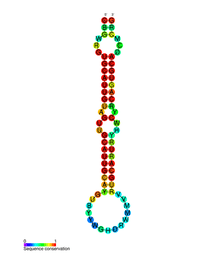miR-33
| miR-33a | |
|---|---|
 | |
| Conserved secondary structure of miR-33a microRNA precursor | |
| Identifiers | |
| Symbol | miR-33a |
| Alt. Symbols | mir33a |
| Rfam | RF00667 |
| miRBase | MI0000091 |
| miRBase family | MIPF0000070 |
| Entrez | 407039 |
| HUGO | 31634 |
| Other data | |
| RNA type | miRNA |
| Domain(s) | Metazoa |
| GO | 0035195 |
| SO | 0001244 |
| Locus | Chr. 22 q13.2 |
| miR-33b | ||
|---|---|---|
| Identifiers | ||
| Symbol | miR-33b | |
| Alt. Symbols | mir33b | |
| Rfam | RF00667 | |
| miRBase | MI0003646 | |
| miRBase family | MIPF0000070 | |
| Entrez | 693120 | |
| HUGO | 32791 | |
| Other data | ||
| RNA type | miRNA | |
| Domain(s) | Metazoa | |
| GO | 0035195 | |
| SO | 0001244 | |
| Locus | Chr. 17 13.2 | |
miR-33 is a family of microRNA precursors, which are processed by the Dicer enzyme to give mature microRNAs.[1] miR-33 is found in several animal species, including humans. In some species there is a single member of this family which gives the mature product mir-33. In humans there are two members of this family called mir-33a and mir-33b, which are located in intronic regions within two protein-coding genes for Sterol regulatory element-binding proteins (SREBP-2 and SREBP-1) respectively.[2]
Function
miR-33 plays a role in lipid metabolism; it downregulates a number of ABC transporters, including ABCA1 and ABCG1, which in turn regulate cholesterol and HDL generation.[3][4] Further related roles of miR-33 have been proposed in fatty acid degradation and in macrophage response to low-density lipoprotein.[2] It has been suggested that miR-33a and miR-33b regulates genes Involved in fatty acid metabolism and insulin signalling.[5]
Potential binding sites for mir-33 have been identified in the cDNA of tumour suppressor p53.[6] Further, study has shown that miR-33 is able to repress p53 expression and p53-induced apoptosis. This function is thought to be related to hematopoietic stem cell renewal.[7]
Applications
miR-33, along with miR-122, could be used to diagnose or treat conditions related to metabolic disorders and cardiovascular disease.[2][8]
References
- ↑ Ambros, V (2001). "microRNAs: tiny regulators with great potential". Cell 107 (7): 823–826. doi:10.1016/S0092-8674(01)00616-X. PMID 11779458.
- ↑ 2.0 2.1 2.2 Najafi-Shoushtari, SH (Jun 2011). "MicroRNAs in cardiometabolic disease.". Current atherosclerosis reports 13 (3): 202–7. doi:10.1007/s11883-011-0179-y. PMID 21461683.
- ↑ Fernández-Hernando, C; Suárez, Y; Rayner, KJ; Moore, KJ (Apr 2011). "MicroRNAs in lipid metabolism.". Current Opinion in Lipidology 22 (2): 86–92. doi:10.1097/MOL.0b013e3283428d9d. PMC 3096067. PMID 21178770.
- ↑ Moore, KJ; Rayner, KJ, Suárez, Y, Fernández-Hernando, C (Dec 2010). "microRNAs and cholesterol metabolism.". Trends in endocrinology and metabolism: TEM 21 (12): 699–706. doi:10.1016/j.tem.2010.08.008. PMC 2991595. PMID 20880716.
- ↑ Dávalos A, Goedeke L, Smibert P, et al. (May 2011). "miR-33a/b contribute to the regulation of fatty acid metabolism and insulin signaling". Proc. Natl. Acad. Sci. U.S.A. 108 (22): 9232–7. doi:10.1073/pnas.1102281108. PMC 3107310. PMID 21576456.
- ↑ Herrera-Merchan, A; Cerrato, C; Luengo, G; Dominguez, O; Piris, MA; Serrano, M; Gonzalez, S (Aug 15, 2010). "miR-33-mediated downregulation of p53 controls hematopoietic stem cell self-renewal.". Cell cycle (Georgetown, Tex.) 9 (16): 3277–85. doi:10.4161/cc.9.16.12598. PMID 20703086.
- ↑ Fuster, JJ; Andrés, V (Sep 1, 2010). "A role for miR-33 in p53 regulation: New perspectives for hematopoietic stem cell research.". Cell cycle (Georgetown, Tex.) 9 (17): 3397–8. doi:10.4161/cc.9.17.13070. PMID 20861665.
- ↑ Najafi-Shoushtari, SH; Kristo, F; Li, Y; Shioda, T; Cohen, DE; Gerszten, RE; Näär, AM (Jun 18, 2010). "MicroRNA-33 and the SREBP host genes cooperate to control cholesterol homeostasis.". Science 328 (5985): 1566–9. doi:10.1126/science.1189123. PMID 20466882.
External links
| ||||||||||||||||||